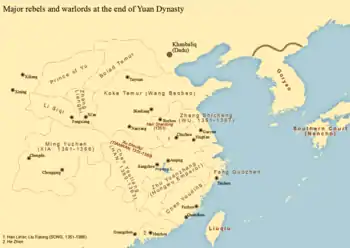Chen Han
Chen Han (陳漢; 陈汉; 1360–1364), or the Great Han (大汉), was a short-lived Chinese dynasty in the middle Yangtze region during the chaotic late Yuan dynasty. It was founded by the Red Turban rebel general Chen Youliang.
Chen Han 陳漢 | |||||||||
|---|---|---|---|---|---|---|---|---|---|
| 1360–1364 | |||||||||
 Chen Han at Yuan dynasty's end | |||||||||
| Capital | Jiujiang, later Wuchang | ||||||||
| Government | Monarchy | ||||||||
| Emperor | |||||||||
• 1360–1363 | Chen Youliang | ||||||||
• 1363–1364 | Chen Li | ||||||||
| History | |||||||||
• Established | 1360 | ||||||||
• Disestablished | 1364 | ||||||||
| |||||||||
| Today part of | China | ||||||||
History
Chen Youliang first dominated, and later assassinated the Red Turban leader Xu Shouhui and usurped his regional regime.
At its height, Chen Han territory encompassed the modern provinces of Hubei, Jiangxi, and Hunan, but Jiangxi mostly fell to another warlord Zhu Yuanzhang in 1361.
In 1363, Chen and Zhu fought in the decisive Battle of Lake Poyang, where Chen was killed.
His teenaged son Chen Li succeeded him, but no longer had the resources to resist the powerful Zhu, who conquered Han the next year.
Chen Li surrendered to Zhu and the Ming dynasty. Chen then moved to Goryeo (Korea), where he had children and became the progenitor of the Korean Yangsan Jin clan.[1]
Genealogy
| Ancestors of Chen Han | ||||||||||||||||||||||||||||||||||||||||||||||||||||||||||||||||||||||||||||||||||||||||||||||||||||||||||||||||||||||||||||||||||||||||||||||||||||||||||||||||||||||||||||||||||||||||||||||||||||||||||||||||||||||||||||||||||||||
|---|---|---|---|---|---|---|---|---|---|---|---|---|---|---|---|---|---|---|---|---|---|---|---|---|---|---|---|---|---|---|---|---|---|---|---|---|---|---|---|---|---|---|---|---|---|---|---|---|---|---|---|---|---|---|---|---|---|---|---|---|---|---|---|---|---|---|---|---|---|---|---|---|---|---|---|---|---|---|---|---|---|---|---|---|---|---|---|---|---|---|---|---|---|---|---|---|---|---|---|---|---|---|---|---|---|---|---|---|---|---|---|---|---|---|---|---|---|---|---|---|---|---|---|---|---|---|---|---|---|---|---|---|---|---|---|---|---|---|---|---|---|---|---|---|---|---|---|---|---|---|---|---|---|---|---|---|---|---|---|---|---|---|---|---|---|---|---|---|---|---|---|---|---|---|---|---|---|---|---|---|---|---|---|---|---|---|---|---|---|---|---|---|---|---|---|---|---|---|---|---|---|---|---|---|---|---|---|---|---|---|---|---|---|---|---|---|---|---|---|---|---|---|---|---|---|---|---|---|---|---|
| ||||||||||||||||||||||||||||||||||||||||||||||||||||||||||||||||||||||||||||||||||||||||||||||||||||||||||||||||||||||||||||||||||||||||||||||||||||||||||||||||||||||||||||||||||||||||||||||||||||||||||||||||||||||||||||||||||||||
- Some Chinese and Vietnamese records indicate that Chen Youliang was the son of Chen Yiji (陳益稷 or Trần Ích Tắc), a Yuan dynasty noble who was originally a leader of the Tran Dynasty.[2][3]
- It is currently unclear what the relation between Chen Pucai and Chen Yiji is, or whether they are in fact the same person.
References
- 《明史/卷123》Mingshi
- 《大越史記全書》本紀卷之七:“甲午(紹豐)十四年元至正十四年春二月,北邊帥臣驛奏,元陳友諒起兵,遣使來乞和親友諒,陳益稷子。”、“辛丑(大治)四年元至正二十一年二月,明太祖攻江州。陳友諒退居武昌,使人來乞師,不許。”
- Ngô Sĩ Liên 1993, p. 251
